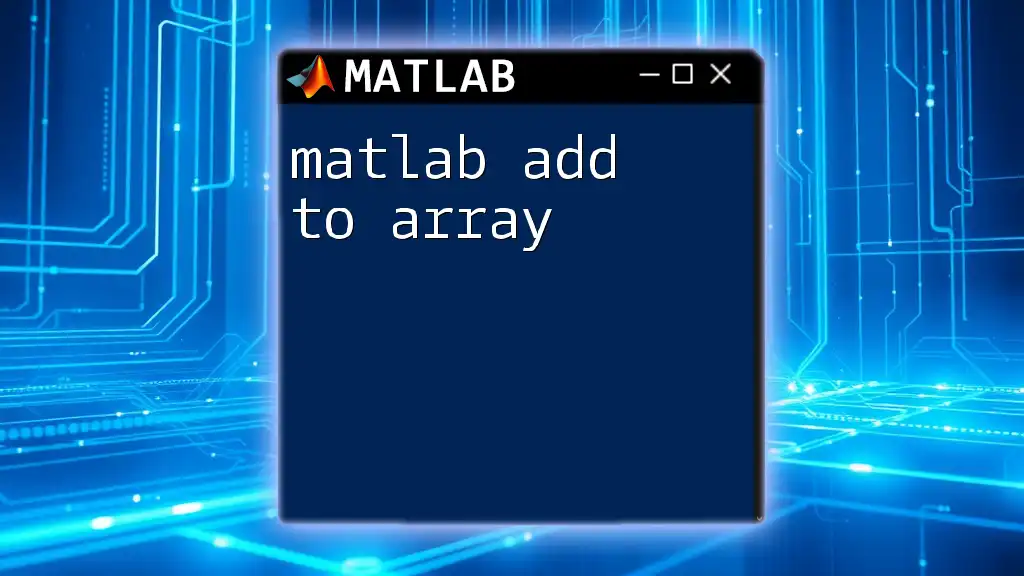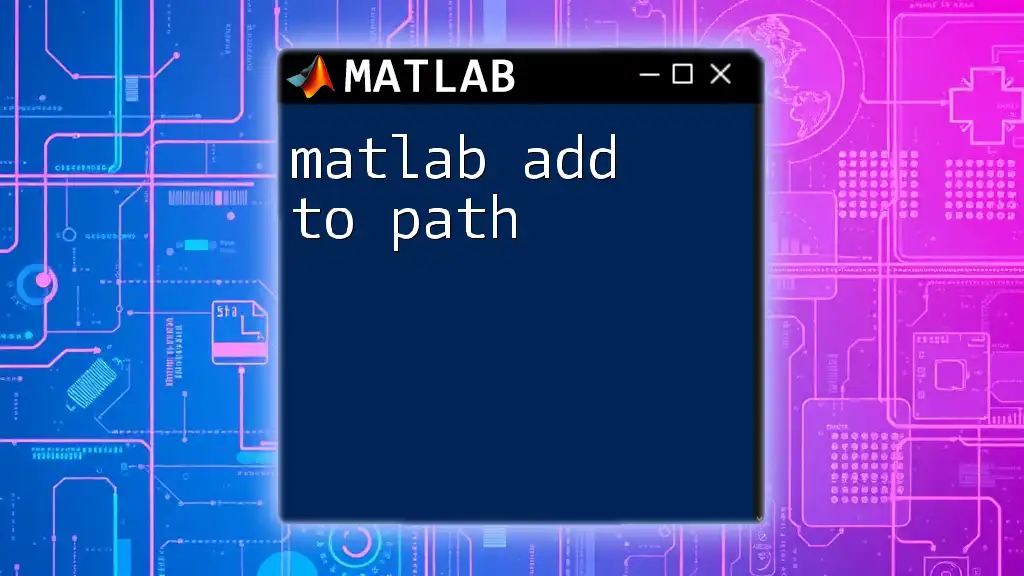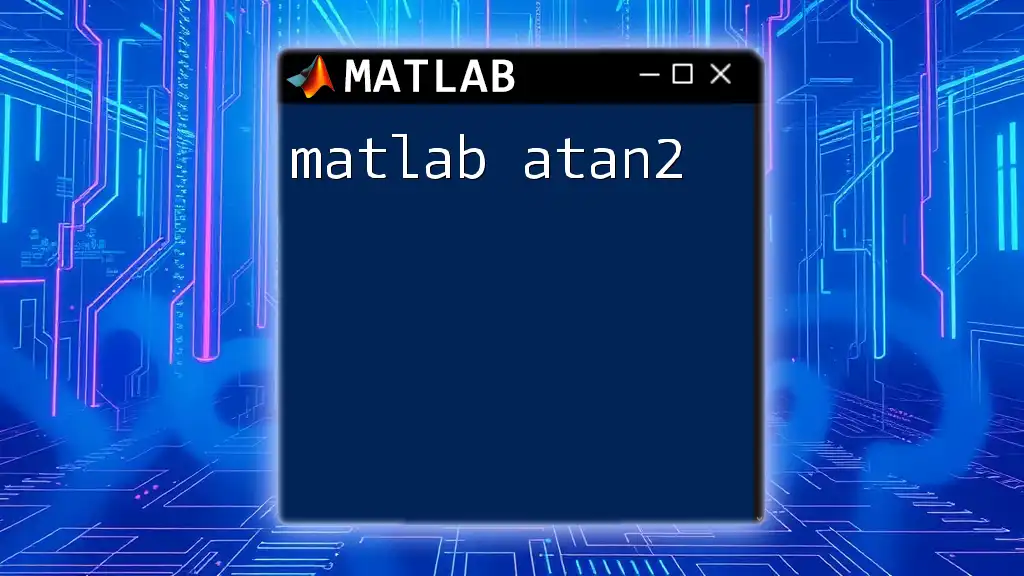The MATLAB `addpath` command allows you to include additional folders to your current search path, enabling MATLAB to access functions and scripts stored in those directories.
addpath('C:\my_functions');
Understanding the MATLAB Search Path
What is the MATLAB Search Path?
The MATLAB search path is a vital aspect of how MATLAB operates, enabling it to locate functions, scripts, and other files. When you execute a command, MATLAB searches its predefined directories to determine if the corresponding file is present. If a file exists in multiple locations, MATLAB will utilize the first occurrence it finds in its search path, which can often lead to confusion if file structures are not well organized.
Default Search Path
By default, MATLAB includes certain folders such as the installation directory, user-defined folders, and various toolbox directories in its search path. Understanding which directories are part of this default setup is crucial because these directories provide immediate access to built-in functions and libraries, which are essential for effective MATLAB programming.

Why You Need to Add to the Path
Benefits of Customizing the Path
Adding custom directories to your MATLAB path allows you to enhance your programming capabilities significantly. It grants access to your scripts and functions, making them easily callable without needing to specify their full directory path. This level of organization is not only convenient but also helps minimize errors in referencing files, especially in larger projects.
Common Scenarios for Adding to Path
There are several scenarios where adding to the path becomes necessary:
- Working with External Toolboxes: If you're using third-party toolboxes that are not installed in the default MATLAB directories, you will need to add these directories to ensure MATLAB can access their functions.
- Collaborating on Projects: When working with colleagues, you may need to share directories that contain scripts and data files critical to your project. Adding these to your path facilitates easier collaboration and seamless integration of everyone’s work.

How to Add Directories to the MATLAB Path
Using the Command Line
One of the simplest ways to add a directory to the MATLAB path is by using the `addpath` command. This command allows you to specify the folder you want MATLAB to recognize. The syntax is straightforward:
addpath(folderPath)
For example, if you have a folder called `MyScripts` located at `C:\`, you would add it to your path using the following command:
addpath('C:\MyScripts');
To ensure you specify the correct `folderPath`, you can navigate to the folder in your file explorer and copy its address directly.
Using MATLAB Interface
You can also add directories via the graphical user interface (GUI), which some users find more intuitive. Here’s how to do it:
- Navigate to the Home Tab in MATLAB.
- Click on Set Path from the Environment section.
- Select Add Folder or Add with Subfolders to include your desired directory.
- After adding, click Save to apply the changes permanently.
This method allows you to visually manage your path, making it easier to keep track of where you are adding directories.
Temporary vs Permanent Path Changes
Temporary Changes
If you need to add a directory temporarily—perhaps for quick testing—understanding this concept is essential. When you use the `addpath` command without saving the path, the addition will only last for the duration of your MATLAB session.
addpath('C:\TempScripts'); % Temporary and will not persist after restart
This temporary adjustment is perfect for short-term tasks or experiments without cluttering your permanent search path.
Permanent Changes
For longer-lasting additions, you can save your changes by employing the `savepath` command. This will ensure that every time you start MATLAB, your custom paths are readily available.
addpath('C:\MyPermanentScripts');
savepath;
In the long run, maintaining a well-organized permanent search path will save you the hassle of re-entering directories with each session.

Managing the Path
Viewing the Current Path
At times, you'll want to check which directories are currently in your MATLAB search path. You can do this by simply typing the `path` command in the command window. This will display all paths currently set, allowing you to verify that your changes have been applied.
currentPath = path;
disp(currentPath);
Removing Directories from the Path
If you find that a directory is no longer necessary or is causing conflicts, you can easily remove it using the `rmpath` command.
rmpath('C:\MyScripts');
By removing obsolete directories, you'll streamline your path and avoid unexpected errors.

Best Practices for Path Management
To maintain an organized workspace, consider the following best practices:
- Regularly audit your search path to ensure you're only keeping the directories you actively need.
- Keep your projects and scripts organized in clearly labeled folders.
- Document the purpose and contents of external scripts and their paths so any collaborators can easily navigate your project setup.

Troubleshooting Path Issues
Common Errors Related to Path
One of the most frequently encountered issues arises when MATLAB cannot find a particular function, resulting in "Function not found" errors. This often indicates that the function's location is not included in the search path.
Tips for Effective Debugging
A handy function when troubleshooting path issues is the `which` command. It helps you locate where a specific function is stored. If you run into a function not found error, this command can assist in determining if the file exists within the current path.
which myFunction; % Find where myFunction is located
It also allows for the identification of shadowed functions, which occur when multiple files share the same name but are located in different directories. This can help you resolve any ambiguities regarding function calls.

Conclusion
Mastering the `matlab add to path` process is crucial for enhancing your coding experience in MATLAB. By understanding how to effectively manage your search path—adding, viewing, and removing directories—you will not only increase your productivity but also ensure a more organized coding environment.

Call to Action
Are you ready to explore the flexibility of customizing your MATLAB environment? Try adding paths now to maximize your programming efficiency! Subscribe for more concise MATLAB tips and tricks that will elevate your coding skills to new heights.

















